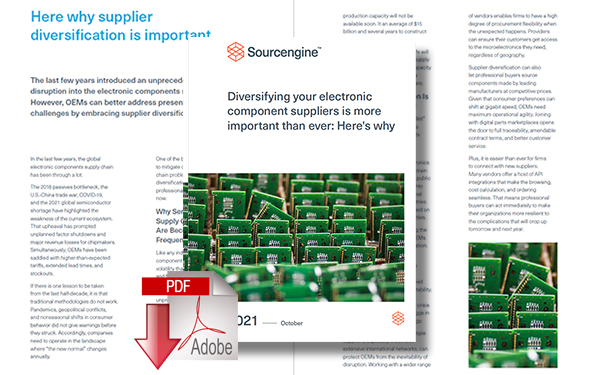Industry Leaders & Analysts Expect the Global Chip Shortage to Extend into 2023

Recently, electronics industry leaders and foundry service provider executives expressed their belief that the chip shortage will persist into 2023.
Global Chip Shortage
In late 2020, a worldwide automotive semiconductor supply bottleneck developed and rapidly evolved into a global chip shortage.
Currently, market watchers estimate the event will cost the vehicle sector $110 billion in revenue this year.
The crisis, now affecting 160 industries, is predicted to negatively impact consumer electronics availability this holiday season.
In response, several leading component makers have ramped up their production to mitigate the crunch's impact.
Unfortunately, the massively debilitating parts scarcity is not expected to end in the near term.
Recently, electronics industry leaders and foundry service provider executives expressed their belief that the chip shortage will persist into 2023.
Moreover, multiple analysts have echoed those sentiments based on the significant ongoing discrepancy between microelectronics supply and demand. However, they also offered multiple recommendations on how manufacturers can navigate the situation.
Top Semiconductor and Electronics Manufacturers Expect Global Chip Shortage Will Last Until 2023
In April, Intel CEO Pat Gelsinger commented that it would take “a couple of years” for the chip sector to rebound from the shortage. He explained the only way to correct the imbalance between supply and demand is to establish additional production capacity. Since modern fabs take years to build and equip, significantly ramping up production is difficult.
Last month, Gelsinger reiterated his forecast in an interview with Bloomberg. But he also stated that the scarcity of automotive and consumer electronics parts would reach an inflection point in the second half of this year.
That said, DigiTimes reported Intel and Advanced Micro Devices (AMD) data center and server ICs have lead times grown to 45 to 66 weeks.
Other major players within the semiconductor industry do not believe the bottleneck will be resolved within the next 17 months.
Flex Ltd., the world’s third-largest OEM and EMS provider, expects that the global chip shortage will continue into 2023. The firm, which counts Ford, HP, and Dyson as clients, has encountered significant disruption because of the crisis. Financial Times noted it temporarily shuttered some of its production lines due to parts insufficiencies.
Lynn Torrel, Flex’s chief procurement and supply chain officer, said Malaysia’s recent nationwide COVID-19 lockdown could exacerbate the crisis. The nation is responsible for around 7 percent of the world’s semiconductor production, so its coronavirus flareup could have long-term repercussions.
Flex CEO Revathi Advaithi posited the chip shortage could have a significant long-term impact on the components supply chain because it occurred in tandem with rising trade tensions in the U.S. and China. The executive believes the overlap between the trade war and the pandemic and will prompt a microelectronics production localization trend.
If that happens, OEMs, CMs, and EMS providers might have trouble restocking the inventories of their overseas factories.
Pure-Play Foundries Expect Chip Crunch to Continue into 2023
Manufacturers are not the only semiconductor industry participants to forecast the microelectronics shortage will continue into 2023.
Along similar lines, GlobalFoundries, the sector’s fourth-largest contract chipmaker, is making similar moves to address the shortage. In May, the company signed a $1.6 billion, three-year silicon supply deal with AMD, improving its liquidity. It also broke ground on a new $4 billion, 300mm wafer facility in Singapore in late June and revealed it would construct a new fab at its New York campus.
However, the foundry’s production capacity expansion will not increase its component production until 2023 at the earliest.
United Microelectronics Corporation (UMC), the world’s third-largest pure-play foundry by revenue, expects the parts crunch will be a long-term problem.
UMC Co-President Chien Shan-chieh observed intense demand for automobile and smart home components is elongating the crisis. The executive specified that robust interest in 8-inch and 12-inch silicon wafers is straining an already diminished supply. He further said the sector’s market imbalance would not be corrected until new production capacity comes online.
In April, UMC declared it would spend $3.5 billion over the next three years expanding its fabrication capabilities. The firm also reportedly made a six-year services agreement with Qualcomm in June, but the size of the deal is unknown. Regardless, the arrangement will provide it with the capital needed to build out its existing infrastructure rapidly.
Samsung announced it would activate a 5nm production line at its Pyeongtaek, South Korea complex in the second half of 2021 because of the shortage. It also indicated it would work with its international partners to tackle the crisis more effectively.
Finally, Taiwan Semiconductor Manufacturing Company (TSMC), the industry’s foremost pure-play foundry, has a more positive view of the crisis. In April, CEO C.C. Wei stated the corporation would not meaningfully increase its output until 2023. But in June, he said the firm would ramp up its fabrication of automotive microcontrollers by 60 percent this year.
Analysts See Parts Bottleneck Persisting into 2023
Despite TSMC’s optimism, multiple semiconductor industry analysts anticipate the bottleneck will persist into 2023.
Forrester Research, a global consultancy, expects chip demand will remain high while parts supplies continue to be constrained throughout 2022. The organization also stated that new surges in coronavirus infections and the Suez Canal blockage extended the shortage. Because of those complications, it forecasts the component scarcity will still be affecting the world in 2023.
Patrick Armstrong, CIO of Plurimi Investment Managers, offered a similar outlook, predicted the semiconductor crunch would last until November 2022. Anderson commented the worldwide problem with continue impacting all sectors that utilize Internet connection-enabling chips through that period.
Credit Suisse indicating correcting the gulf between supply and demand in the field will be a multi-year process. Wenzhe Zhao, the organization’s director of global economics and strategy, said the time-intensive process of establishing new production capacity is the obstacle to resolving the shortage. He also anticipates manufacturers will begin inventory hoarding to avoid future supply chain-related operational paralysis.
EE Times recently spoke to one industry watcher who holds the opinion the global chip shortage will hang on until 2023.
Arete Research senior analyst Brett Simpson pointed out the technological evolution will contribute to the bottleneck. He explained that automakers are integrating more advanced silicon into their vehicles to make them more efficient and multifaceted. As that segment migrates to purchasing newer image sensors, power ICs, and display drivers, 8-inch foundry space will be strained.
How OEMs, CMs, and EMS Providers Can Deal the Protracted Global Chip Shortage
Many large corporations, chipmakers, and foundry service providers agree about when the global component crisis will be resolved. But high-level recommendations for dealing with the crisis in the here and now are harder to come by. One reason why is that the bottleneck that began two years ago has no readily available solution.
Holding out until supply chain conditions improve is not a luxury all OEMs, CMs, and EMS providers enjoy. Accordingly, it is useful to absorb insights provided by industry insiders with robust institutional memory and expansive data access.
Earlier this year, Gartner suggested OEMs pre-book production capacity with foundry service providers and OSAT companies. It advised that firms increase their market intelligence to track supply chain disruptions before their own operations are affected. The organization also stated that procurement specialists should extend their market visibility to silicon production going forward.
IHS Markit made similar recommendations, telling manufacturers to monitor changes in chipmaker lead times and stockouts carefully. That way, they can create component stockpiles large enough to endure long waits in between inventory refreshes. It also mentioned that creating designs that incorporate parts with many alternates and crosses is a good strategy.
Glenn O’Donnell, a vice president, and research director with Forrester, said buyers should strive to be flexible, improvisational, and patient. That means considering alternate configurations for products requiring hard-to-find microelectronics and teaming with other businesses to spread the load of higher costs.
In addition, Gartner, IHS Markit, and Forrester all recommend that companies bring more providers into their supply chains. Working with new partners can help firms acquire the components they need even amid the global shortage. However, with microchip counterfeiting on the rise recently, manufacturers should be very careful when extending their procurement resources.
OEMs would be best served by using an electronic components e-commerce marketplace with rigorous quality assurance standards and global fulfillment capability.
Further Reading: No Light at the End of the Tunnel Yet for the Global Semiconductor Shortage
Related White Papers
9 Key Considerations When Shopping for Electronic Components Online
A comprehensive white paper exploring the key considerations that all procurement professionals should keep in mind when shopping for electronic components online. Download Now!
Semiconductor Q3 2021 Lead Time Report
A comprehensive analysis of how value-added services are revolutionizing an industry. Download Now!
Why Chipmakers Cannot Quickly Fix the Global Semiconductor Shortage
In this white paper, we detail how large corporations and national governments are trying to resolve the global chip shortage, and how the complex nature of the semiconductor industry means there is no quick fix for the crisis. Download Now!
How OEMs Can Use Ecommerce Platforms without Compromising Their Quality Assurance Standards
In this white paper, we discuss why electronics OEMs, e-commerce represents have a tremendous opportunity, and why many online marketplaces are struggling with counterfeit product problems, however, companies can enjoy the benefits of digitalization without compromising their standards. Download Now!
Here’s Why Diversifying Your Electronic Component Suppliers is More Important Than Ever
This white paper details why the last few years introduced an unprecedented level of disruption into the electronic components supply chain, and how OEMs can better address present and future challenges by embracing supplier diversification. Download Now!
More Resources from Sourcengine
Related Article: Sourcengine Beats Forecast by 252% Amid Ongoing Component Shortages, Supply Chain Evolution
Article Topics
Sourcengine News & Resources
The Impact of Inflation on the Electronics Components Supply Chain Industry How Rising Inflation is Disrupting the Electronics Components Supply Chain Semiconductor Q2 2022 Lead Time Report Global Electronic Component Shortage - May Update Semiconductor Q1 2022 Lead Time Report Global Electronic Component Shortage - March Update Predictions for the 2022 Global Semiconductor Sector More SourcengineLatest in Technology
Spotlight Startup: Cart.com is Reimagining Logistics Walmart and Swisslog Expand Partnership with New Texas Facility Taking Stock of Today’s Robotics Market and What the Future Holds Biden Gives Samsung $6.4 Billion For Texas Semiconductor Plants Apple Overtaken as World’s Largest Phone Seller Walmart Unleashes Autonomous Lift Trucks at Four High-Tech DCs Talking Supply Chain: Procurement and the AI revolution More Technology

















